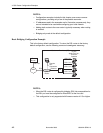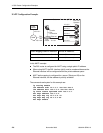
4. DSL Router Configuration Examples
4-8 November 2003 6300-A2-GB20-10
Simultaneous Basic NAT and NAPT Configuration Example
The DSL router can be configured for Basic NAT and NAPT simultaneously. In the
private address space, multiple work stations can use NAPT and the servers can
use Basic NAT. This allows a server to support traffic other than TCP/UDP traffic
and accommodate multiple inbound traffic types. Using Basic NAT also allows you
to have multiple servers of the same type (Web, FTP, Telnet) on the private
network. All private addresses not specified in a Basic NAT map command will be
translated via NAPT.
In this Simultaneous Basic NAT and NAPT example:
Since Basic NAT is enabled and the dsl1 interface address is on the same
subnet as the Basic NAT global IP network address, Proxy ARP must be
enabled on the DSL interface (dsl1).
If IP Scoping is enabled, the client’s NAT mapping public IP addresses and the
dsl1 interface IP address must be entered into the client VNID table.
The commands and syntax for this example are:
ip routing enable
ifn address eth1 10.1.3.1 255.255.255.0
ifn address dsl1 155.1.3.2 255.255.255.0
ip route create upstream eth1 155.1.3.1
nat basic address 155.1.3.0
nat napt address 155.1.3.2
nat basic map 155.1.3.3 10.1.3.2 10.1.3.3
nat basic enable
nat napt enable
proxy arp dsl1 enable
01-16967
Customer Premises (CP)
DSL
Router
Hub
10.1.3.3
10.1.3.6
10.1.3.7
Web Server/
FTP/Telnet
Console
Port
Connection
Ethernet
eth1
10.1.3.1
DSL
Core
Router
dsl1
155.1.3.2
WAN
155.1.3.1
10.1.3.8
10.1.3.2
Web
Server


















